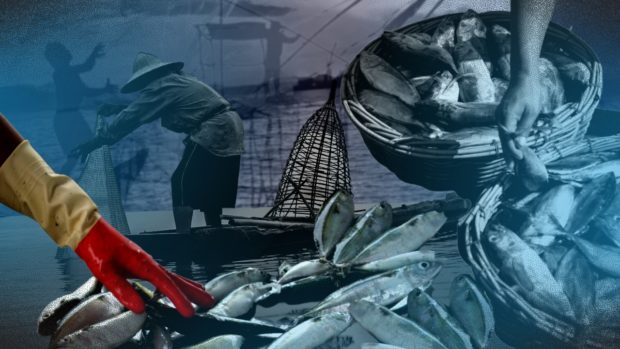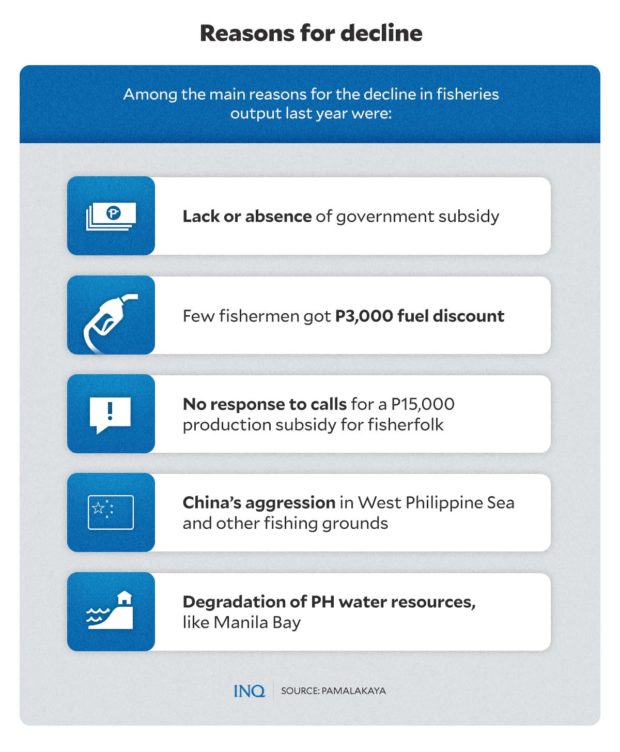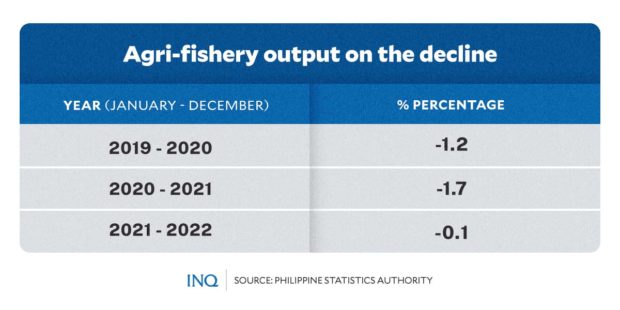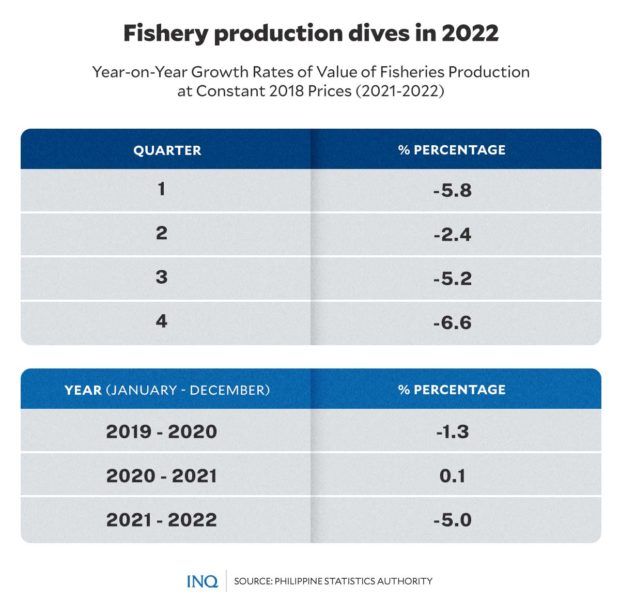Alarm raised over 3-year, continuing decline in harvests, fish catch
MANILA, Philippines—The all-year-round decline in fisheries production in 2022 and three straight years of agri-fisheries losses should alarm the current administration, according to a progressive fisherfolk group.
Fisherfolk organization Pambansang Lakas ng Kilusang Mamamalakaya ng Pilipinas (Pamalakaya), citing data from the Philippine Statistics Authority (PSA), showed that agri-fisheries production went down by 1 percent in the fourth quarter of 2022 and overall contracted by 0.1 percent that year.
The decline in agri-fisheries output last year marked the third straight year of contraction, following the -1.7 percent and -1.2 percent in 2021 and 2020.
“This is an indication that the government has neglected the agriculture and fisheries sector in the country,” said Pamalakaya National Spokesperson Ronnel Arambulo in a statement.
“The successive year-on-year decline in production in agriculture and fisheries is very worrisome. This will explain why the price of basic foods in the country is also increasing,” Arambulo added.
Fisheries output dive
Last year’s most significant drop in fisheries output was around 6.6 percent, recorded during the fourth quarter or from October to December.
Fishery production fell by 5.8 percent during the first quarter, 2.4 percent in the second quarter, and 5.2 percent for the third quarter of that same period.
The PSA noted double-digit declines in the production of the following species last year:
- Mudcrab (Alimango): -28.7 percent
- Blue Crab (Alimasag): -19.7 percent
- Tiger Prawn (Sugpo): -19.6 percent
- Indian Mackerel (Alumahan): -19.2 percent
- Slipmouth (Sapsap): -15.1 percent
- Milkfish (Bangus): -12.6 percent
- Cavalla (Talakitok): -12.1 percent
- Bali Sardinella (Tamban): -12.1 percent
- Tilapia: -10.7 percent
Decreases were also recorded for the following species:
- Frigate Tuna (Tulingan): -9.7 percent
- Grouper (Lapu-lapu): -8.5 percent
- Threadfin Bream (Bisugo): -3.8 percent
- Roundscad (Galunggong): -3.8 percent
“This is not just data or numbers but the actual situation of farmers and fishermen who are simultaneously suffering from burdensome programs and government negligence,” Arambulo said.
The main culprits
According to Pamalakaya, one of the key factors behind the decline in production of the agriculture and fisheries sector was the consecutive increases in oil prices last year, which limited the hours and days of fishing by small fisherfolk.
In October last year, the group said that fisherfolk had either abandoned their livelihood and found alternative jobs or reduced their fishing activities as their meager income made it challenging for them to recover ever-rising production costs.
It explained that at least 80 percent of fisherfolk’s earnings go to fuel alone.
In its recent statement, Pamalakaya pointed to the absence or insufficient subsidy support from the government. The group also said that out of over two million registered fishermen across the country, only 79,000 became beneficiaries of “the meager P3,000 fuel discount.”
READ: Fuel subsidy set for agrisector; P3 price hike seen
Last year, several agriculture groups also batted for a P15,000 production subsidy that will cover at least two months of fuel expenses of a fisher—which the past and current administrations have yet to respond to.
READ: Fisherfolk want workers’ pay hike, fuel subsidy
The other main reasons cited by Pamalakaya also include restrictive access to major fishing ground, such as the West Philippine Sea, due to the aggressive presence of Chinese vessels in the disputed waters.
The group added that the gradual degradation of some of the country’s water resources, like Manila Bay, due to destructive conversion and reclamation projects could have also triggered the decline in agri-fisheries output in the past years.
New agri chief
“In this state of our agriculture and fisheries, a new DA (Department of Agriculture) secretary who has deep knowledge, is not careless, and has the ability to address the grievances of farmers and fishermen is more needed,” said Arambulo.
President Ferdinand “Bongbong” Marcos Jr., who concurrently leads the country’s agriculture department, has yet to appoint someone to take on the role of DA’s full-time secretary.
Last week, amid the deepening challenges in the farming sector, Marcos said he decided to keep his concurrent position as agriculture secretary.
READ: Bongbong Marcos on staying on as agri chief: ‘They cannot say no’
“For me, in the DA, there really are things that I can do that it would take [a permanent secretary] a long time,” he said in an interview with selected members of the press, later aired on state television.
“The president, they cannot say no to. And if they don’t fulfill my order, I can chastise them,” he said in reply to a question about calls made by some lawmakers for a full-time agriculture secretary.
READ: Cynthia Villar: Next Agriculture secretary must have ‘heart for small farmers’
TSB
RELATED STORIES:
Inexplicable price hikes, supply confusion: After onion, garlic may be next
What we know so far about ‘out of control’ rise in onion prices
The PH onion conundrum: Solutions elusive, stop-gaps at best




